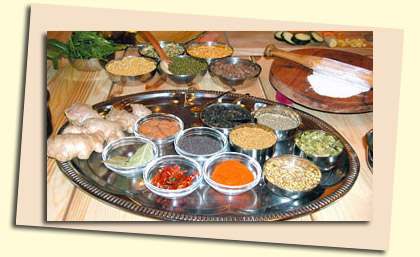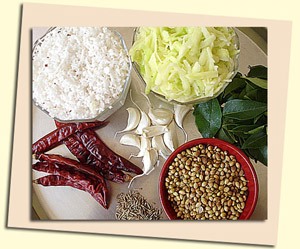Ayurveda Cooking - Introduction of Ayurveda Cooking |
|||||||||||||
|
|||||||||||||
|
Introduction of Ayurveda Cooking |
|||||||||||||
|
|
|||||||||||||
| Ayurvedic Cooking | |||||||||||||
|
|||||||||||||
|
Vata, Pitta and Kapha. A complete balance of all these doshas is mandatory for health of an individual. Every individual has a distinct balance, and the health and well being of an individual depend on right balance of the three doshas ("tridoshas"). Because these five elements exist in us and in nature as well, our doshas can become aggravated or imbalanced due to inappropriate or inadequate diet, change of seasons, climate or lifestyle, and result in disease in the body. Ayurveda cooking provides great insight about foods that suit and balance you according to your constitution, dosha imbalance, and season. |
|||||||||||||
|
Ayurvedic cooking includes the knowledge and use of herbs, spices, vegetables, legumes etc to maintain physical, mental, social and spiritual harmony. Ayurveda foods are appetizing, flavourful and aromatic and offer healing and good health when served in an inspiring atmosphere. Ayurveda foods help to clean the accumulated toxins (which are a result of improperly digested food) and rejuvenate the body as each dish is cooked and spiced to achieve maximum digestibility.
The fundamental
principles of Ayurvedic Cooking are:
These principles
guide to determine the cooking processes, food combinations, uses of
different food items, quantity of intake of food, etc. Every individual
has a unique body constitution (Dosha) and needs different foods to
maintain overall health. For example, Vata is a cold dry dosha, hence
person with Vata as predominant dosha need warm, nourishing foods, while
the Pitta person requires cool food to balance his fire element. Ayurvedic
cooking also take into account the effect of cooking method on the quality
of the foods, the feelings of the cook and of the vibrations of
surrounding atmosphere, the compatibility of foods, the time of cooking
and eating, the cycle of the seasons. Ayurveda considered food as a
stimulant to a higher consciousness. |
|||||||||||||
| Everyday Ayurvedic Cooking | |||||||||||||
|
|||||||||||||
|
beans of the green whole mung beans from which the green skins have been removed. Split mung is lightest among all beans hence, easiest to digest. It is useful for everyone as it balances all the doshas. It is a good source of protein and has astringent taste. You can spice your dahl by adding ghee-spice mixture at the end when it is completely cooked. To prepare the ghee-spice mixture gently sauté the spices into ghee until you get the aroma of spices.
There are many
varieties of rice but Ayurveda considered Basmati rice the most
beneficial. As a grain, it is recommended for all because it balances all
the doshas. However, consuming rice every day is not suggested because it
is a little heavy. People with a kapha imbalance can make it bit lighter
by dry roasting it before adding the water for cooking. Quinoa, barley or
couscous can also be used for the grains portion of the meal. Delicious
Quinoa is rich source of protein and fast to cook. To sauté the vegetable first gently fry the spices in the ghee and then add the chopped raw vegetables to the spice mixture and stir so that all the spices are mixed with the vegetables. You can add a couple of spoonfuls of water if it sticks with pan. Cover and cook on low heat until the vegetables are well cooked. Vegetable should not be mushy, but just "fork friendly". Add salt to taste at the end and some fresh cilantro (coriander) leaves tos garnish. |
|||||||||||||
|
|||||||||||||
|
lactobacilli that are essential for a well-functioning digestive tract. This yogurt drink helps to reduce bloating, allows the digestion of the lunch to be smoother, and adds nutrition. It is not recommended in the evening.
Chapatis made of whole-wheat flour are also main ingredient of Ayurvedic
meal. These energy-enhancing foods flatbreads add an extra taste to the
diet. It is best to have homemade chapatis but you can also purchase
organic chapatis from food stores if you do not have time to prepare them
at home. The readymade chapattis must be heated before serving. This wholesome, nutritious, and balanced Ayurvedic meal can be easily prepared at home. With practice, the above-mentioned meal would only take about 15 minutes for preparation and about 25 minutes to cook. Now, enjoy fresh home-cooked ayurvedic meal and stay healthy for life. |
|||||||||||||
|
|||||||||||||
|
|||||||||||||







